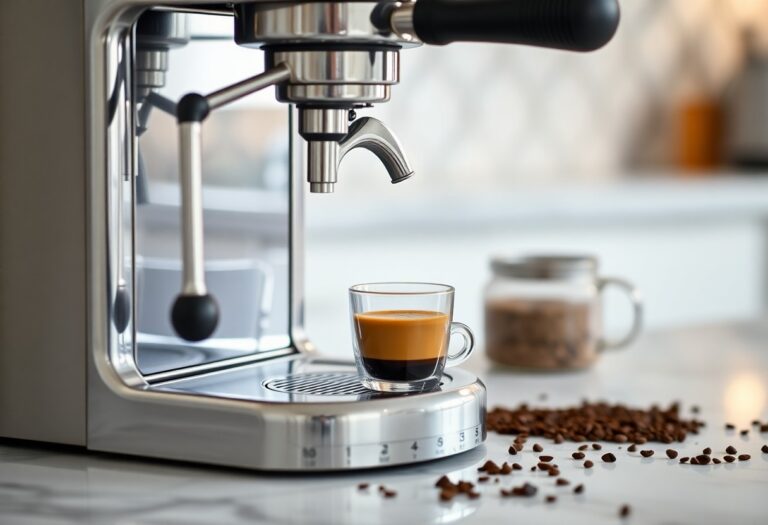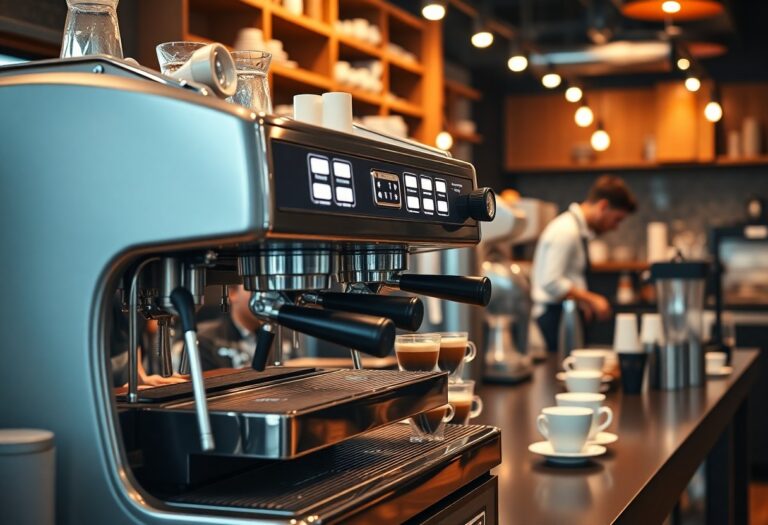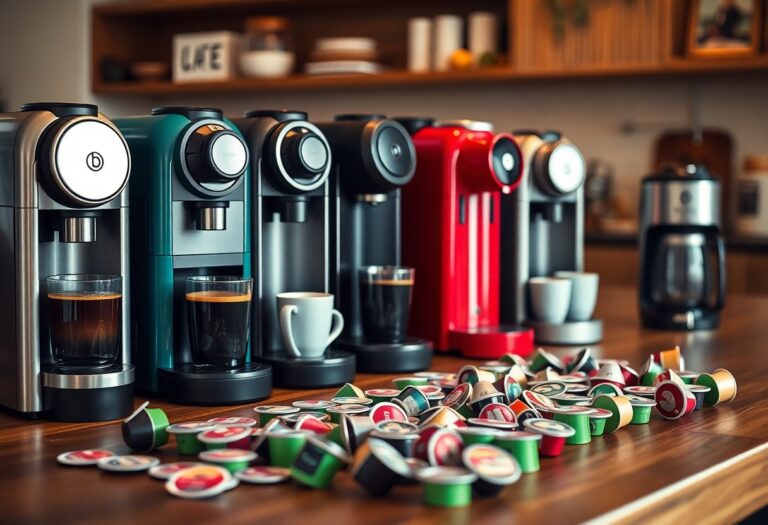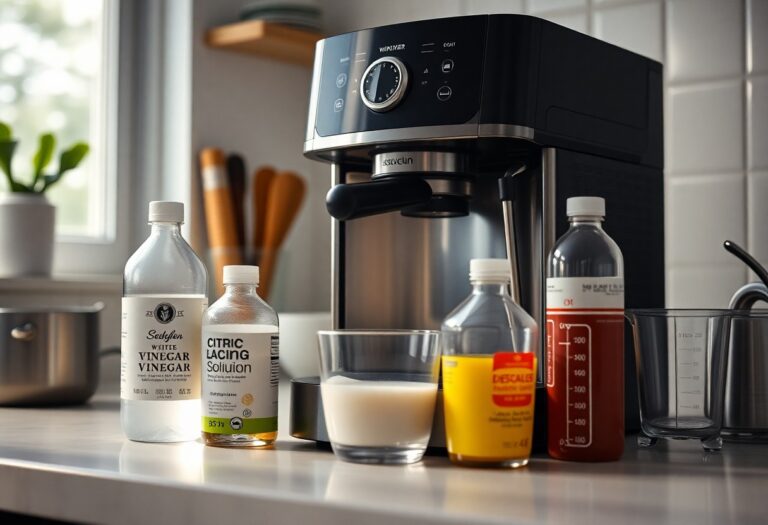What Coffee Goes in an Espresso Machine – Bean Selection
Over time, choosing the right coffee beans for your espresso machine can significantly impact the quality of your brew. You should look for high-quality Arabica beans, as these offer a balance of flavor and acidity that enhances your espresso experience. Freshness is also key; always opt for beans that have been roasted within the last couple of weeks. Experimenting with different roast levels will help you discover your personal preferences, whether you enjoy light, medium, or dark roasts. Selecting the right beans is your first step towards crafting the perfect espresso at home.

Key Takeaways:
- Espresso requires a fine grind size, typically produced from coffee beans roasted specifically for espresso.
- Dark roasts are popular for espresso due to their bold flavors, but medium roasts can also yield a rich, complex profile.
- Blend options often include Arabica and Robusta beans; Arabica for sweetness and complexity, while Robusta adds crema and body.
- Freshness is vital; using freshly roasted beans enhances the flavor and aroma of the espresso.
- Experimenting with different single-origin beans can provide unique taste experiences and allow customization of the espresso profile.
Decoding Espresso Bean Varieties
Understanding the various types of espresso beans can enhance your brewing experience. The primary varieties used in espresso are Arabica and Robusta, each with distinct flavor profiles and characteristics that appeal to different preferences. Exploring these options allows you to discover the nuances in taste, aroma, and intensity that can elevate your espresso game.
Arabica vs. Robusta: The Flavor Faceoff
Arabica and Robusta not only differ in taste but also in caffeine content; Arabica beans typically offer a smoother, sweeter flavor with a hint of acidity, while Robusta boasts a bolder, earthier tone with higher caffeine levels. You may find the luxurious notes of Arabica more appealing, or the robust kick of Robusta might suit your needs better, especially in blends.
Single Origin vs. Blends: Finding Your Richness
Single origin coffees come from a specific region, allowing you to explore unique flavor profiles tied to that area, while blends combine beans from various origins to create a balanced cup. Experimenting with both can reveal a spectrum of richness; single origin may excite your palate with bright, distinct notes, whereas blends often provide a fuller, more harmonious flavor.
Single origin beans often reflect the terroir of their region, showcasing specific flavors based on climate and soil conditions. For instance, Ethiopian single origins can flaunt vibrant fruitiness, while Colombian beans might impart a smooth, caramel-like sweetness. Blends, on the other hand, can smooth out any rough edges, offering a consistent and well-rounded taste. The blending process allows roasters to balance the strengths of different beans, providing a tailored experience that achieves complexity and depth, which could align perfectly with your personal espresso preferences.
Roasting Profiles: The Game Changer
Understanding roasting profiles can dramatically elevate your espresso-making experience. The profile—whether light, medium, or dark—determines the flavor complexity and mouthfeel of your espresso. For example, a medium roast may enhance sweetness while preserving more nuanced characteristics, while a dark roast typically yields bolder, more bitter notes. Knowing how these profiles affect your espresso can guide your bean selection and ultimately enhance your brewing technique.
Light Roast vs. Dark Roast: Taste and Grinding Implications
Light and dark roasts produce distinctly different flavors and textures in your espresso. Light roasts retain more of the bean’s natural acidity and floral notes, creating a vibrant flavor profile, whereas dark roasts lean towards bitter, smoky tastes. Grinding implications can’t be overlooked; light roasts benefit from a finer grind to extract delicate flavors, while dark roasts can handle a slightly coarser grind that captures robust, bold notes.
Freshness and Its Impact on Espresso Quality
Freshness of your coffee beans plays a pivotal role in crafting the perfect espresso. Beans are best within two weeks of roasting, as they release gases that can alter taste quality over time. Using stale beans results in a flat cup, lacking the rich flavors you desire. Ensure you’re sourcing beans from reputable roasters who prioritize freshness—a key aspect in achieving a vibrant and aromatic espresso.
After roasting, coffee beans continue to release carbon dioxide, a process known as “degassing.” This typically peaks around 48 hours post-roast and diminishes significantly after two weeks. The difference between brewing with fresh beans and those past their prime is like night and day; fresh beans maximize flavor potential, enhancing sweetness, complexity, and crema. For the best espresso at home, aim for a supply of fresh beans that are roasted to your preferred profile, and always purchase in small batches to ensure ultimate freshness.
The Ideal Grind: Matching Bean to Machine
Each espresso machine has specific requirements for grind size to yield the best shots. At its core, the grind should be fine enough to provide the necessary resistance during extraction while allowing water to flow through effectively. Finding the right grind for your machine can significantly transform your coffee experience, leading to richer flavors and a beautifully creamed espresso.
Why Consistency is Key: Particle Size Matters
Achieving a consistent grind size ensures that water flows evenly through the coffee grounds, leading to a balanced extraction. Variability in particle size can result in channeling, where water bypasses some grounds, leading to under-extracted, sour flavors or over-extracted, bitter notes. Investing in a quality grinder that produces uniform particles can dramatically improve your espresso’s overall quality.
Grind Size Adjustments for Optimal Extraction
Small adjustments in grind size can make a significant difference in extraction time and flavor profile. For instance, if your espresso is pulling too quickly, a finer grind may help slow down the flow, enhancing flavor extraction. Conversely, if it’s taking too long, a coarser grind allows for faster water passage, preventing over-extraction.
Pay attention to the extraction time; ideally, a single shot should take about 25-30 seconds. If your shot is running quicker than that, try adjusting your grind slightly finer. Alternatively, if it’s taking longer and producing bitterness, a coarser grind may be beneficial. Fine-tuning these variables can help you achieve your desired taste and improve your espresso skillset, ensuring every cup is tailored to your preference.
Choosing the Right Roast for Your Espresso Machine
Roast selection significantly influences the flavor profile of your espresso. For a balanced shot with rich crema, focus on medium to dark roasts, which highlight the natural chocolate and nutty notes desired in espresso. You can dive deeper into the aspect of ground types by checking out this guide on What Type of Ground Coffee for Espresso Machine. Overall, choosing a roast comes down to personal preference, but understanding the characteristics of each can enhance your coffee experience.
Recommendations for Home Machines: Tailored Selections
For home espresso machines, blends that are well-rounded with balanced acidity and sweetness work best. Look for beans labeled as espresso blends, which are specifically crafted to extract vibrant flavors under lower pressure. Brands that offer medium to dark roast profiles with tasting notes of chocolate, caramel, or fruity undertones often suit home brewers’ needs, ensuring a delightful shot every time.
Professional Machines: Beans that Shine Under Pressure
Professional espresso machines demand high-quality beans that can withstand the intensity of high-pressure extraction. This means opting for single-origin beans or premium blends with bold flavors and complex profiles. Look for darker roasts that provide a robust flavor, as they stand up to the machine’s power, delivering intense shots that cut through milk for exceptional lattes and cappuccinos.
When utilizing professional machines, consider beans that have undergone meticulous processing and roasting to amplify their unique flavors. Typically, specialty coffee beans designed for baristas boast rich body and clarity in flavor, revealing notes of caramel, toasted nuts, or even subtle fruitiness. Beans from regions such as Ethiopia or Colombia often shine in these settings, offering a beautiful complexity that enhances your espresso drinks, whether you’re crafting an exquisite ristretto or a classic macchiato.

Your Personal Taste: Experimentation and Preferences
Personalizing your espresso experience hinges on experimentation. You’ll uncover your preferences by trying various roasts and blends. Best beans for espresso when getting started can serve as a solid foundation, but don’t hesitate to step outside the box. Differences in origin, roast profiles, and even grind settings can yield unique flavor profiles that cater to your distinct taste demands.
Developing Your Palate: Tasting Techniques
To refine your palate, employ tasting techniques similar to those used in wine tasting. Focus on different flavor notes by sipping espresso slowly, identifying acidity, sweetness, and body. Utilize notes or journals to document what you enjoy or dislike about each cup. This systematic approach will sharpen your taste and guide future purchases.
Unconventional Beans: Expanding Your Espresso Horizons
Daring to explore unconventional beans can significantly widen your espresso experience. Specialty coffees from micro-lots, rare varietals, or even blends that defy traditional profiles bring exciting flavors to your cup. For example, *Cascara*, the dried fruit of the coffee cherry, can provide a unique twist; furthermore, exploring beans from lesser-known regions might surprise your taste buds with distinctive flavors.
Engaging with unconventional beans might lead you to discover unexpected nuances in your espresso. For instance, beans sourced from regions like Papua New Guinea could surprise you with their fruity and floral notes, while those from Yemen often possess complex spicy undertones. Roasters continuously innovate, experimenting with fermentation and processing techniques to create unique flavor profiles, presenting you with exciting options beyond the standard espresso fare.
Final Words
With these considerations in mind, you can confidently choose the right coffee beans for your espresso machine. Prioritize freshness, opt for a medium to dark roast, and explore single-origin versus blends based on your flavor preferences. Keep in mind the grind size and extraction time to achieve that perfect espresso shot. By making informed decisions regarding bean selection, you can elevate your espresso game and enjoy richer, more flavorful coffee experiences tailored to your taste.
FAQ
Q: What type of coffee beans are best for using in an espresso machine?
A: The best coffee beans for espresso machines are typically medium to dark roasts, as they provide a rich and strong flavor profile. Arabica beans are the most popular choice due to their smooth taste and balanced acidity, although some espresso blends include a percentage of Robusta beans to enhance crema and body.
Q: Should I choose single-origin beans or blends for my espresso?
A: Both single-origin and blended beans can be suitable for espresso; it largely depends on your taste preference. Single-origin beans offer unique flavors from specific regions, while blends are crafted to achieve a balanced and complex profile. If you enjoy experimenting, try both to see which suits your palate better.
Q: How fresh should my coffee beans be for espresso?
A: Freshness is vital for optimal flavor. It’s recommended to use coffee beans roasted within the last 2-4 weeks. After roasting, coffee beans begin to lose their flavor as they degas and oxidize. Store your beans in an airtight container in a cool, dark place to maintain their freshness longer.
Q: Is there a specific grind size for espresso coffee beans?
A: Yes, the grind size is crucial for brewing espresso effectively. It should be fine, akin to table salt, which allows for the proper extraction during the short brewing time. If the grind is too coarse, the espresso will be weak, while a grind that’s too fine can lead to over-extraction and bitterness.
Q: How do I choose the right roast level for my espresso?
A: The right roast level depends on your taste preferences and the flavor profile you desire. Light roasts tend to showcase brighter acidity and floral notes, while medium roasts offer a balance of sweetness and acidity. Dark roasts are rich and bold with darker chocolate or caramel notes. Experiment with different roast levels to find your favorite espresso experience.







